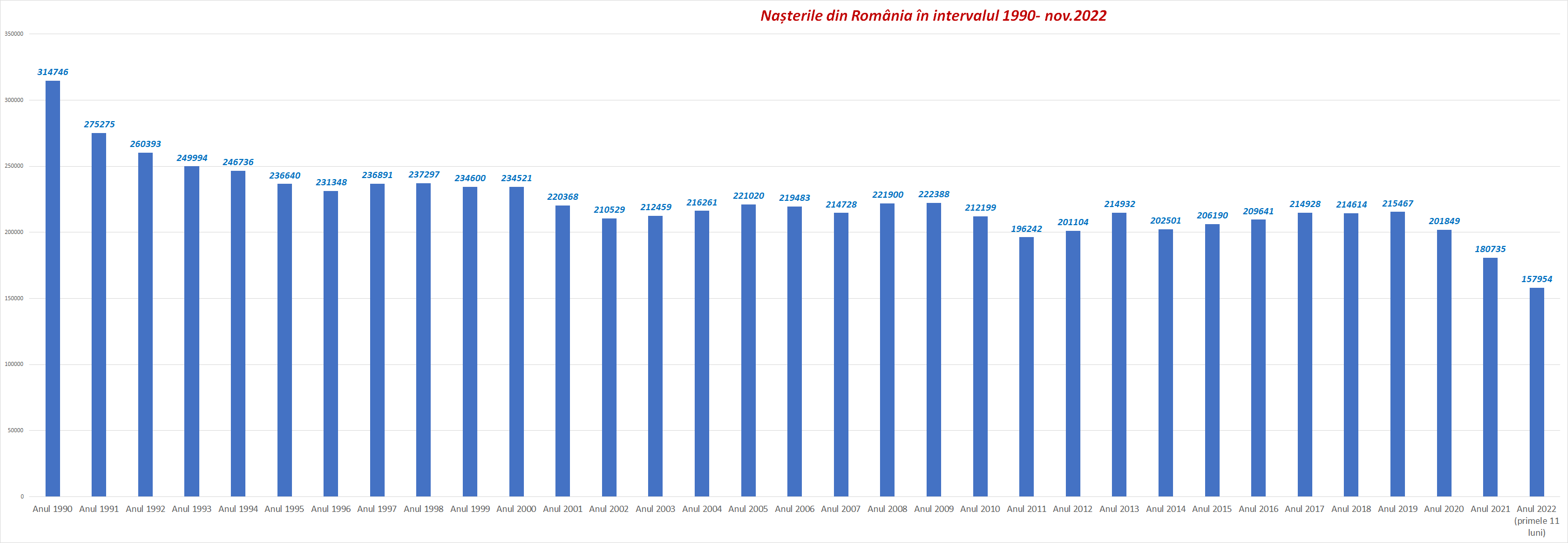
In November 2022, 13,205 births were registered, almost 2,000 less than in October 2022, making the number of newborns in 11 months the lowest in the last 130 years.
More than 400,000 children were born in 1888, and the annual average did not drop below 200,000 until 1918 (immediately after the war) and then after the 1989 revolution. according to the INS.
Even if 12-13 thousand children were born in December (the average number of children born in December in recent years), the data would not change the general picture.
Birth and the concept of family or parenthood are constantly changing.

How the concept of family has changed over the past 50 years
According to sociologist Maria Voynei, the main changes in family models can be summarized as follows:
- regarding “family-society” relations, a decrease in the importance of the family’s economic function;
- secularization and partial deinstitutionalization of the family;
- “emancipation” of women; acceptance by society of some family functions; reduction of family and neighborhood relations; reduction of community control over demographic behavior;
- increasing the material well-being of families;
- increasing concern of the family about social problems;
- Behavior of unmarried youth – expansion of premarital sexual experience;
- fertility control;
- continuation of premarital cohabitation;
- the spread of permanent celibacy and single-person households;
- increasing social permissiveness and parents’ tolerance for premarital behavior of young people.”
The family is often richer than it was 4-5 decades ago, because women make a significant contribution to the increase in income.
These changes are rather evidence of a change in attitude towards the family, and not so much a loss of interest in the institution of the family and its values.
In addition, Maria Voinea notes, in Romania we observe a decrease in the birth rate, a decrease in the number of marriages, an increase in the number of divorces, frequent cohabitation, the phenomenon of abandonment, etc. These changes are rather evidence of a change in attitudes towards marriage and the family, and not so much a loss of interest in these institutions and their values, says the Romanian sociologist.
Family behavior also appears to be modified: “the importance of emotional and affective relationships between partners is increasing; spouses’ concern about the quality of family life increases; forms of coexistence are diversifying: hence the relative decline of the nuclear family based on marriage, the expansion of consensual couples, the expansion of relations between people living in different families, the emergence of social norms that regulate new forms of coexistence, increasing social tolerance for these new forms cohabitation; change in relations between partners: the tendency to equalize the power positions of men, the emancipation of the position of women, greater social acceptability of extramarital sexual relations, increasing the importance of the commonality of concerns, mentalities, attitudes and interests; changing birth rates and the role of children, the relative increase in the instability of the nuclear family: increased divorce rates, lower remarriage rates, greater individual and social acceptability of divorce.
For an ancient traditional family, which was mainly engaged in agriculture, children were a valuable help in the household
In the past, for a traditional family that was mainly engaged in agriculture, children represented valuable help in the household and a guarantee of support in old age. Streams of support were directed from parents to children and vice versa.
As the source of income shifted from agricultural households to industry and services, children became consumers: support flows only from parents to children.
The earning opportunities that arise in this new environment are much wider than those offered by traditional agriculture, but require the possession of a fairly high educational capital – especially if we refer to the requirements of the activities performed in the traditional family.
Thus, the investment that must be made in a child to form a personality with high chances of social and professional integration in modern European societies is much higher than in the past. To be able to achieve this goal, the family must focus on the quality of the offspring.
The couple tries to combine the desire to have children with the interest in maintaining their standard of living
The costs of having offspring, which are considered to be qualitatively satisfactory, are so high, “the couple tries to reconcile the desire to have children with the interest of maintaining the standard of living and ensuring an increase in the quality of the offspring. On the other hand, it can be noted that there are many more children in families that do not care much about the quality of offspring,” says Maria Voynya.
A study conducted by the National Institute of Statistics and Economic Research in France shows that after 1960, the French family also experienced a number of transformations:
- – the number of marriages and repeated families decreased, but the number of free unions increased;
- – increased number of divorces or separate relationships;
- – the number of single-parent families and mixed families has increased (and one of the spouses has at least one child from a previous marriage);
- – the number of births decreased;
- – the number of children born out of wedlock has increased;
- – the number of working women has increased
Obviously, this decline in the birth rate will have economic and social consequences very seriously
Sources: Maria Voinea, Contemporary Family. A small encyclopedia
Source: Hot News
Mary Robinson is a renowned journalist in the field of Automobile. She currently works as a writer at 247 news reel. With a keen eye for detail and a passion for all things Automotive, Mary’s writing provides readers with in-depth analysis and unique perspectives on the latest developments in the field.